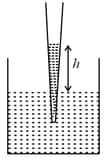EASY
Earn 100
In case of water and glass, we get a concave meniscus because the adhesive force between water and glass are _________ than the cohesive forces between water molecules.
(a)weaker
(b)stronger
(c)same
(d)none of the mentioned
33.33% studentsanswered this correctly
Important Questions on Mechanical Properties of Fluids
EASY
EASY
EASY
Two light balls are suspended as shown in figure. When a stream of air passes through the space between them, the distance between the balls will

EASY
EASY
EASY
EASY
EASY
The rise of liquid in capillary is more than that of water in the same capillary. Which one of the following is the CORRECT reason?
EASY

EASY
EASY
EASY
EASY
EASY
EASY
EASY
EASY
EASY
EASY
(Surface tension of water
EASY

